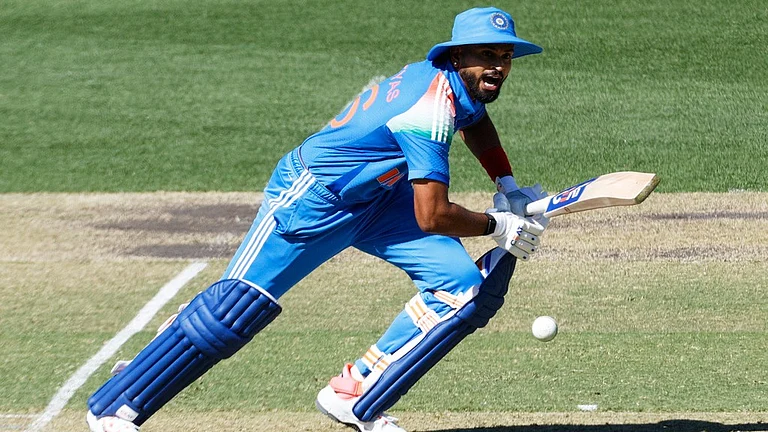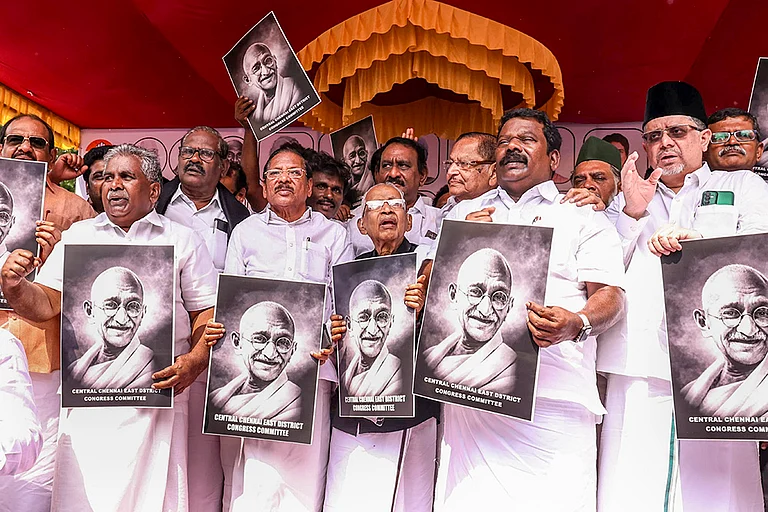Nanjamma, a domestic worker and mother of two, living in south Bengaluru’s Talaghattapura, was overjoyed when she heard that Congress was winning the 2023 Legislative Assembly election in Karnataka. Even as the Bharatiya Janata Party (BJP) swept Bengaluru, Nanjamma, who is the sole bread earner of her family, is happy that her vote in favour of the Congress had not gone to waste. When asked why she voted for Congress, Nanjamma says that it was a matter of survival.
“Despite having voter cards, we do not get ration on time. My husband is an alcoholic and cannot support our needs. I have to look after the family. How will I do that if we do not get food as per our requirements?” she asks. With a salary of Rs 6,000, Nanjamma feels that the “empty promises” of political parties will not fill their stomachs.
“The BJP people tried to lure us with money to vote for them but we are not going to be swayed. I still have kids that I have to attend to. We will not believe in fake promises,” she says.
The Congress made a thumping comeback in Karnataka, winning 122 of the 224 seats in the 2023 Karnataka Legislative Assembly Elections, as per the latest figures published by the Election Commission (EC). Calling it a victory of the “Janata Janardhan”, the All India Congress Committee (AICC) President Mallikarjun Kharge said that all party leaders have “worked unitedly and people have voted for our ‘guarantees’”.
According to analysts, the Congress victory can be attributed to its steadfast decision to stay away from Hindutva rhetoric and communal identity politics while sticking to developmental planks and local issues of employment, price rice, and cash guarantees. For thousands of women like Nanjamma, the victory seems personal. And analysts feel that votes of women like Nanjamma and the youth may have played a decisive role in the Congress’ success.
Women a strong vote bank
According to political analyst Gautham Machaiah, women are an important vote bank in Karnataka today which is why all parties make an effort to reach out to them.
“Four of the five guarantees announced by the Congress have targeted women or the households. They include free bus travel, monthly assistance of Rs 2,000 for woman head of family, 10 kg food grains for BPL (Below Poverty Line) families and 200 units of free electricity,” Machaiah states. It also promised to buy cow dung at Rs 3 per kg and establish compost/manure centres involving rural women and youth.
The BJP, in its turn, promised three cooking gas cylinders in a year during festivals, 10 kg of food grains and half a litre of milk, free bus travel and hostels for working women, financial assistance and nutritional kits for pregnant women and an increase in pension for widows.
The successive rise in women voters through state elections in Karnataka also points to the growing importance of women in state elections.
At 43.7 per cent, the number of women voters almost equals that of men, he says.
“As per the Election Commission, the number of women voters has gone up from 2.49 crore in 2018 to 2.59 crore in 2023 and the number of male voters from 2.55 crore to 2.62 crore. Also, 50 per cent of seats (112 out of 224) in the state now have more female voters, compared to 2018, when there were 67 seats with more women voters,” he adds.
This year in Karnataka, women voters outnumbered male voters in 43 of its total 224 assembly constituencies and across six of its 34 districts. Across the state, women registered a 72.7 per cent voter turnout, slightly lower than the male turnout at 73.68 per cent across the state. But there was an increase of women’s votes from 71.5 per cent from the 2018 Legislative Assembly Elections.
As of now, there is no empirical data to concretely state which way the women’s vote swung this time.
“But considering the fact that women voters exceed men in 50 per cent of the constituencies, it is obvious that they played a decisive role in the Congress performance,” Machaiah avers, adding that one of the factors that women across the state were agitated over was price rise.
Political activist and commentator Tara Krishnaswamy, co-founder of Political Shakti, a non-profit group that campaigns for more women MLAs and MPs in India, agrees, adding that the results also show disillusionment among women with the BJP.
“The previous full-term Congress government of 2013-18 under Siddaramaiah was particularly known for welfare schemes like the Anna Bhagya Scheme, the Indira Canteen scheme as well as the various maternity benefits given to women,” Krishnaswamy notes. “When the BJP government took over, they cancelled many of those schemes like the Indira Canteen. The Anna Bhagya scheme was also reduced. When you give people guarantees, then take it away or reduce it, people don’t forget, especially women won’t forget it because that means her family is going hungry.”
Krishnaswamy adds that Congress did not focus specifically on women but on issues that affect a majority of people in the state.
“The Congress guarantees address generic issue that impact majority of the population. However, women are particularly tuned in to those issues since they are the ones the most affected. When there is unemployment, women are the first to lose jobs in the informal sector. When prices of groceries or gas cylinders rise, women are, again, the first to be impacted as they take care of the household economy,” Krishnaswamy states.
Even when men lose jobs, women suffer as the burden of running the household falls squarely on women and there are studies linking the incidence of rise in domestic violence against women when male members of the family lose jobs.
Observers also note that policies like the hijab ban alienated several sections of Muslim women and feminists. “If you look at the hijab-halal bans, throwing Muslim traders out of Hindu temple areas—all of this happened in the run-up to the 2022 elections in Uttar Pradesh. These were not actual issues in Karnataka but ones created by the party in power to boost its campaigns elsewhere,” Krishnaswamy notes.
Women and the right wing
In the past decade, women’s votes have become a key factor across several states, making them a prime target for political candidates by all parties. In Bihar, women have often been regarded as the “silent voters” that rally behind JD(U) leader Nitish Kumar. In Bihar, where voter turnout of women was higher than men in 166 of total 243 constituencies, analysis of results showed that out of 125 seats the NDA won in Bihar Assembly elections, 99 came from constituencies that saw a higher voting percentage of women than men.
In 2022, data from Axis My-India and Lokniti-CSDS post-poll survey confirmed that more women seem to have voted for the BJP than men in all four states the party won elections in. Traditionally, a party that faced a gender disadvantage, the BJP seems to have reversed this trend between the 2014 and 2019 elections.
Microanalysis of the data, however, reveals that though voting for the BJP, women may not necessarily be voting for Hindutva. The Axis-My India poll survey of the Uttar Pradesh 2022 elections stated that “the single biggest difference between both the parties is female voters. Women are voting extraordinarily in the favour of the BJP where the difference is 16 per cent as against 4 per cent difference among male voters”.
However, when read in conjunction with other aspects of the report, the data revealed more nuanced insights. Political preferences of women after classifying them by their caste identities, for instance, showed that within its core support base of Yadavs and Muslims, the Samajwadi Party actually has a greater support among women than men.
When it comes to right-wing philosophies like Hindutva and ethno-nationalism, women nevertheless play an important and complicated role. The 2022 book Women, Gender and Religious Nationalism edited by Amrita Basu and Tanika Sarkar tackles the question of why women advance or support Hindutva or right-wing ideologies/strategies. The answer is complex. Feminist scholars argue that despite conservative views on gender, right wing ideologies and spaces like the Sangh Parivar in India allow women space —albeit limited— in male-dominated political spheres, through several techniques like storytelling and “culture” gate-keeping.
“Right wing proliferation on the ground brings women within the Hindutva fold by including them in religious functions, satsangs, Mahila Sammelans, etc that typically carry out religious events,” says political scientist Muzaffar Assadi of Mysore University. “In areas like western Karnataka where competitive communalism is in practice among various communities, these events are also a fertile ground for recruiting OBC votes, both male and female, in the Hindutva fold.”
Such mobilisation of the Hindu right-wing can also be seen in other sexual minorities as trans community, several sections of which in India have now become religiously aligned with the Sangh. The question then is perhaps this: Would the women and sexual minorities who are voting for Hindutva continue to do so if they enjoyed equal rights, autonomy, and representation in society?
The most significant political challenge for women, nevertheless, continues to be in the lack of representation in spaces of power and administration. Despite bold pitches to woo women voters, including promises for 33 per cent reservation of seats for women in the Lok Sabha and state legislative assemblies, only 5 per cent of the total candidates fielded by the BJP and Congress were women. The BJP gave tickets to 12 women while Congress fielded just 11. While an increase in voter turnout is a positive sign, direct political power continues to remain concentrated in the hands of men.


























